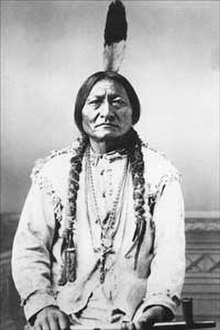Sioux
| Očhéthi Šakówiŋ | |
|---|---|

|
|
| Total population | |
| (170,110) | |
| Regions with significant populations | |
| US: (SD, MN, NE, MT, ND, IA, WI, IL, WY) Canada: (MB, SK, AB) |
|
| Languages | |
| Sioux language (Lakota, Western Dakota, Eastern Dakota), Assiniboine, Stoney, English | |
| Religion | |
| Christianity (incl. syncretistic forms), traditional religion | |
| Related ethnic groups | |
| Assiniboine, Dakota, Lakota, Nakoda (Stoney), and other Siouan-speaking peoples |
The Sioux /ˈsuː/ are groups of Native American tribes and First Nations peoples in North America. The term can refer to any ethnic group within the Great Sioux Nation or to any of the nation's many language dialects. The Sioux comprise three major divisions based on language divisions: the Dakota, Lakota, and Nakota.
The Santee Dakota (Isáŋyathi; "Knife") reside in the extreme east of the Dakotas, Minnesota and northern Iowa. The Yankton and Yanktonai Dakota (Iháŋktȟuŋwaŋ and Iháŋktȟuŋwaŋna; "Village-at-the-end" and "Little village-at-the-end"), collectively also referred to by the endonym Wičhíyena, reside in the Minnesota River area. They are considered to be the middle Sioux, and have in the past been erroneously classified as Nakota. The actual Nakota are the Assiniboine and Stoney of Western Canada and Montana. The Lakota, also called Teton (Thítȟuŋwaŋ; possibly "Dwellers on the prairie"), are the westernmost Sioux, known for their hunting and warrior culture.
Today, the Sioux maintain many separate tribal governments scattered across several reservations, communities, and reserves in North Dakota, South Dakota, Nebraska, Minnesota, and Montana in the United States; and Manitoba and southern Saskatchewan in Canada.
...
Wikipedia
